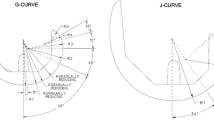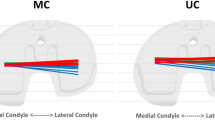Abstract
Total knee arthroplasty (TKA) is one of the most successful ways of treating pain and functional limitations due to osteoarthritis. Asians and Middle Easterners need a large range of flexi angles for religious, social, and cultural activities. Prayer activities and seiza required flexible angle from 150° to 165°. To support these activities, a TKA high flexion (high-flex) type is required. The application of high-flex TKA causes a difference between extension gap and flexion gap, called gap difference. Gap difference is strongly influenced by posterior tibial slope (PTS) and single radius system, and it causes TKA instability. This study aims to analyze the stability of AKJ with GD measurement on a single radius system with a computer-aided design (CAD) approach to prayer, social, and cultural activities for Asians, especially in Indonesia. This study uses the CAD approach with stages that are implant scanning, surface processing, curve processing, components improvement, and gap difference measurement. This study has successfully tested the stability of the model against the difference between gap extension and gap flexion. TKA model with a maximum of PTS 6° can be recommended for the purposes of Asian activities, especially Indonesians in religious, social, and cultural activities. In the future, stability tests will be needed for the movement of anterior–posterior translation.
Access this chapter
Tax calculation will be finalised at checkout
Purchases are for personal use only
Similar content being viewed by others
References
Guo L, Yang L, Briard JL, Jun Duan X, You Wang F (2012) Long-term survival analysis of posterior cruciate-retaining total knee arthroplasty, knee surgery. Sport Traumatol Arthrosc 20:1760–1765
Farahini H, Moghtadaei M, Bagheri A, Akbarian E (2013) Factors influencing range of motion after total knee arthroplasty. Iran Red Crescent Med J 15:10–15
Park KK, Chang CB, Kang YG, Seong SC, Kim TK (2007) Correlation of maximum flexion with clinical outcome after total knee replacement in Asian patients. J Bone Jt Surg Ser B 89:604–608
Long WJ, Scuderi GR (2008) High-flexion total knee arthroplasty. J Arthroplasty 23:6–10
Acker SM, Cockburn RA, Krevolin J, Li RM, Tarabichi S, Wyss UP (2011) Knee kinematics of high-flexion activities of daily living performed by male Muslims in the middle east. J Arthroplasty 26:319–327
Lestari H, Izzhati DN, Rachmat N, Setyawan D, Saputra E, Ismail R (2015) Measurement of the range of motion on the knees of Indonesians as preliminary data for the design of artificial upper knee legs (original in Indonesia). Snst 64–69
Shi X, Shen B, Kang P, Yang J, Zhou Z, Pei F (2013) The effect of posterior tibial slope on knee flexion in posterior-stabilized total knee arthroplasty, knee surgery. Sport Traumatol Arthrosc 21:2696–2703
Fujito T, Tomita T, Yamazaki T, Oda K, Yoshikawa H, Sugamoto K (2018) Influence of posterior tibial slope on kinematics after cruciate-retaining total knee arthroplasty. J Arthroplasty 33:3778–3782
Massin P, Gournay A (2006) Optimization of the posterior condylar offset, tibial slope, and condylar roll-back in total knee arthroplasty. J Arthroplasty 21:889–896
Darmanto D, Novriansyah R, Ismail R, Jamari J, Anggoro PW, Bayuseno AP (2022) Reconstruction of the artificial knee joint using a reverse engineering approach based on computer-aided design. J Med Eng Technol 46:136–147
Yang G, Chen W, Sun X, Zhou D, Chen S, Zhang L (2016) Full-thickness cartilage-based posterior femoral condylar offset. Influence on knee flexion after posterior-stabilized total knee arthroplasty. Orthop Traumatol Surg 102:441–446
Kim YH, Park JW (2020) Comparison of modular conventional and high-flexion posterior-stabilized total knee arthroplasties in the same patients at a mean follow-up of 15 years. J Arthroplasty 35:1262–1267
Kim YH, Park JW, Kim JS (2017) Do high-flexion total knee designs increase the risk of femoral component loosening? J Arthroplasty 32:1862–1868
Carey BW, Harty J (2018) A comparison of clinical- and patient-reported outcomes of the cemented ATTUNE and PFC sigma fixed bearing cruciate sacrificing knee systems in patients who underwent total knee replacement with both prostheses in opposite knees. J Orthop Surg Res 13:1–5
Song SJ, Park CH, Liang H, Kang SG, Park JJ, Bae DK (2018) Comparison of clinical results and injury risk of posterior tibial cortex between attune and press fit condylar sigma knee systems. J Arthroplasty 33:391–397
Darmanto D, Novriansyah R, Ismail R, Jamari J, Bayuseno AP, Anggoro PW (2021) Computer-aided design for analyzing the influence of single radius on flexion angle of artificial knee joint, 114–118. https://doi.org/10.1109/ibitec53045.2021.9649381
Nowakowski AM, Kamphausen M, Pagenstert G, Valderrabano V, Müller-Gerbl M (2014) Influence of tibial slope on extension and flexion gaps in total knee arthroplasty: increasing the tibial slope affects both gaps. Int Orthop 38:2071–2077
Watanabe M, Tanaka Y, Kuriyama S, Nakamura S, Nishitani K, Sekiguchi K, Ito H, Matsuda S (2019) Impact of intraoperative adjustment method for increased flexion gap on knee kinematics after posterior cruciate ligament-sacrificing total knee arthroplasty. Clin Biomech 63:85–94
van Lieshout WAM, Koenraadt KLM, Elmans LHGJ, van Geenen RCI (2020) Flexion first balancer: description of new technique in TKA to reproduce joint line and pre-disease mechanical alignment. J Exp Orthop 7:4–9
Chia ZY, Pang HN, Tan MH, Yeo SJ (2018) Gap difference in navigated TKA: a measure of the imbalanced flexion-extension gap. Sicot-J. 4:30
Okazaki K, Tashiro Y, Mizu-uchi H, Hamai S, Doi T, Iwamoto Y (2014) Influence of the posterior tibial slope on the flexion gap in total knee arthroplasty. Knee 21:806–809
Matziolis G, Hube R, Perka C, Matziolis D (2012) Increased flexion position of the femoral component reduces the flexion gap in total knee arthroplasty, knee surgery. Sport Traumatol Arthrosc 20:1092–1096
Yoon JR, Il Jeong H, Oh KJ, Yang JH (2013) In vivo gap analysis in various knee flexion angles during navigation-assisted total knee arthroplasty. J Arthroplasty 28:1796–1800
Shimizu N, Tomita T, Yamazaki T, Yoshikawa H, Sugamoto K (2014) In vivo movement of femoral flexion axis of a single-radius total knee arthroplasty. J Arthroplasty 29:2407–2411
Piles L, Reig MJ, Seguí VJ, Pla R, Martínez F, Seguí JM (2019) Reverse engineering applied to biomodelling and pathological bone manufacturing using FDM technology. Procedia Manuf 41:739–746
Haleem A, Javaid M, Khan RH, Suman R (2020) 3D printing applications in bone tissue engineering. J Clin Orthop Trauma 11:S118–S124
Zhou F, Xue F, Zhang S (2020) The application of 3D printing patient specific instrumentation model in total knee arthroplasty, Saudi. J Biol Sci 27:1217–1221
Takagi H, Asai S, Kawashima F, Kato S, Sato A, Okumo T, Kanzaki K (2020) A gap balancing technique for adjusting the component gap in total knee arthroplasty using a navigation system, Asia-Pacific. J Sport Med Arthrosc Rehabil Technol 21:17–21
Kang KT, Kwon SK, Son J, Kwon OR, Lee JS, Koh YG (2018) Effects of posterior condylar offset and posterior tibial slope on mobile-bearing total knee arthroplasty using computational simulation. Knee 25:903–914
Kang KT, Koh YG, Son J, Kwon OR, Lee JS, Kwon SK (2017) Influence of increased posterior tibial slope in total knee arthroplasty on knee joint biomechanics: a computational simulation study. J Arthroplasty 33:572–579
Bottros J, Gad B, Krebs V, Barsoum WK (2006) Gap balancing in total knee arthroplasty. J Arthroplasty 21:11–15
Mullaji A, Sharma A, Marawar S, Kanna R (2009) Quantification of effect of sequential posteromedial release on flexion and extension gaps. a computer-assisted study in cadaveric knees. J Arthroplasty 24:795–805
Acknowledgements
The authors thank to Deputy for Strengthening Research and Development, the Ministry of Research and Technology and Higher Education, Republic of Indonesia, for research funding under Doctoral Research Grants of number: 017/ES/PG.02.00.PT/2022 and 18752/UN7.6.1/PP/2022.
Author information
Authors and Affiliations
Corresponding author
Editor information
Editors and Affiliations
Rights and permissions
Copyright information
© 2024 The Author(s), under exclusive license to Springer Nature Singapore Pte Ltd.
About this paper
Cite this paper
Darmanto, D., Novriansyah, R., Ismail, R., Jamari, J., Bayuseno, A.P., Anggoro, P.W. (2024). The Posterior Tibial Slope Effect to Gap Difference on a Single Radius System for Total Knee Arthroplasty Based on the Computer-Aided Design Approach. In: Irwansyah, Iqbal, M., Huzni, S., Akhyar (eds) Proceedings of the 4th International Conference on Experimental and Computational Mechanics in Engineering. ICECME 2022. Lecture Notes in Mechanical Engineering. Springer, Singapore. https://doi.org/10.1007/978-981-99-7495-5_1
Download citation
DOI: https://doi.org/10.1007/978-981-99-7495-5_1
Published:
Publisher Name: Springer, Singapore
Print ISBN: 978-981-99-7494-8
Online ISBN: 978-981-99-7495-5
eBook Packages: EngineeringEngineering (R0)




